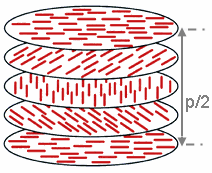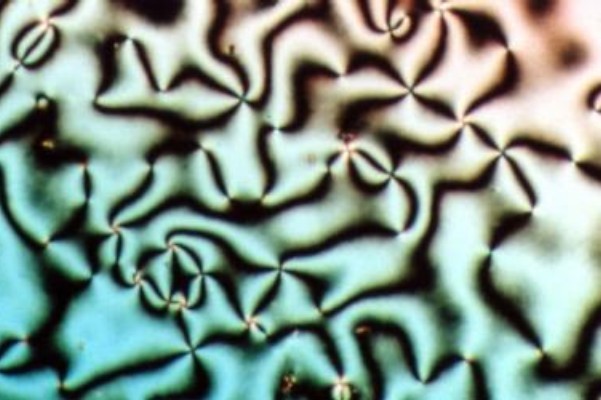|
Cholesteric Liquid Crystal
A cholesteric liquid-crystal display (ChLCD) is a display containing a liquid crystal with a Helix, helical structure and which is therefore Chirality (chemistry), chiral. Cholesteric liquid crystals are also known as ''Liquid crystal#Chiral phases, chiral nematic liquid crystals''. They organize in layers with no positional ordering within layers, but a director axis which varies with layers. The variation of the director axis tends to be periodic in nature. The period of this variation (the distance over which a full rotation of 360° is completed) is known as the pitch, p. This pitch determines the wavelength of light which is reflected (Bragg reflection, Bragg Reflection). The technology is characterized by stable states i.e. focal conic state (dark state) and planar state (bright state). Displays based on this technology are called “bistable” and don’t need any power to maintain the information (zero power). Because of the reflective nature of the ChLCD, these displays ... [...More Info...] [...Related Items...] OR: [Wikipedia] [Google] [Baidu] |
Liquid Crystal
Liquid crystal (LC) is a state of matter whose properties are between those of conventional liquids and those of solid crystals. For example, a liquid crystal may flow like a liquid, but its molecules may be oriented in a crystal-like way. There are many types of LC phases, which can be distinguished by their optical properties (such as textures). The contrasting textures arise due to molecules within one area of material ("domain") being oriented in the same direction but different areas having different orientations. LC materials may not always be in a LC state of matter (just as water may be ice or water vapor). Liquid crystals can be divided into 3 main types: * thermotropic, *lyotropic, and * metallotropic. Thermotropic and lyotropic liquid crystals consist mostly of organic molecules, although a few minerals are also known. Thermotropic LCs exhibit a phase transition into the LC phase as temperature changes. Lyotropic LCs exhibit phase transitions as a function of b ... [...More Info...] [...Related Items...] OR: [Wikipedia] [Google] [Baidu] |
Helix
A helix () is a shape like a corkscrew or spiral staircase. It is a type of smooth space curve with tangent lines at a constant angle to a fixed axis. Helices are important in biology, as the DNA molecule is formed as two intertwined helices, and many proteins have helical substructures, known as alpha helices. The word ''helix'' comes from the Greek word ''ἕλιξ'', "twisted, curved". A "filled-in" helix – for example, a "spiral" (helical) ramp – is a surface called ''helicoid''. Properties and types The ''pitch'' of a helix is the height of one complete helix turn, measured parallel to the axis of the helix. A double helix consists of two (typically congruent) helices with the same axis, differing by a translation along the axis. A circular helix (i.e. one with constant radius) has constant band curvature and constant torsion. A ''conic helix'', also known as a ''conic spiral'', may be defined as a spiral on a conic surface, with the distance to the apex an expo ... [...More Info...] [...Related Items...] OR: [Wikipedia] [Google] [Baidu] |
Chirality (chemistry)
In chemistry, a molecule or ion is called chiral () if it cannot be superposed on its mirror image by any combination of rotation (geometry), rotations, translation (geometry), translations, and some Conformational isomerism, conformational changes. This geometric property is called chirality (). The terms are derived from Ancient Greek χείρ (''cheir'') 'hand'; which is the canonical example of an object with this property. A chiral molecule or ion exists in two stereoisomers that are mirror images of each other, called enantiomers; they are often distinguished as either "right-handed" or "left-handed" by their absolute configuration or some other criterion. The two enantiomers have the same chemical properties, except when reacting with other chiral compounds. They also have the same physics, physical properties, except that they often have opposite optical activity, optical activities. A homogeneous mixture of the two enantiomers in equal parts is said to be racemic mixtu ... [...More Info...] [...Related Items...] OR: [Wikipedia] [Google] [Baidu] |
Liquid Crystal
Liquid crystal (LC) is a state of matter whose properties are between those of conventional liquids and those of solid crystals. For example, a liquid crystal may flow like a liquid, but its molecules may be oriented in a crystal-like way. There are many types of LC phases, which can be distinguished by their optical properties (such as textures). The contrasting textures arise due to molecules within one area of material ("domain") being oriented in the same direction but different areas having different orientations. LC materials may not always be in a LC state of matter (just as water may be ice or water vapor). Liquid crystals can be divided into 3 main types: * thermotropic, *lyotropic, and * metallotropic. Thermotropic and lyotropic liquid crystals consist mostly of organic molecules, although a few minerals are also known. Thermotropic LCs exhibit a phase transition into the LC phase as temperature changes. Lyotropic LCs exhibit phase transitions as a function of b ... [...More Info...] [...Related Items...] OR: [Wikipedia] [Google] [Baidu] |
Bragg Reflection
In physics and chemistry , Bragg's law, Wulff–Bragg's condition or Laue–Bragg interference, a special case of Laue diffraction, gives the angles for coherent scattering of waves from a crystal lattice. It encompasses the superposition of wave fronts scattered by lattice planes, leading to a strict relation between wavelength and scattering angle, or else to the wavevector transfer with respect to the crystal lattice. Such law had initially been formulated for X-rays upon crystals. However, It applies to all sorts of quantum beams, including neutron and electron waves at atomic distances, as well as visible light at artificial periodic microscale lattices. History Bragg diffraction (also referred to as the Bragg formulation of X-ray diffraction) was first proposed by Lawrence Bragg and his father, William Henry Bragg, in 1913 in response to their discovery that crystalline solids produced surprising patterns of reflected X-rays (in contrast to that of, say, a liquid). They ... [...More Info...] [...Related Items...] OR: [Wikipedia] [Google] [Baidu] |
Hydroxypropyl Cellulose
Hydroxypropyl cellulose (HPC) is a derivative of cellulose with both water solubility and organic solubility. It is used as an excipient, and topical ophthalmic protectant and lubricant. Chemistry HPC is an ether of cellulose in which some of the hydroxyl groups in the repeating glucose units have been hydroxypropylated forming -OCH2CH(OH)CH3 groups using propylene oxide. The average number of substituted hydroxyl groups per glucose unit is referred to as the degree of substitution (DS). Complete substitution would provide a DS of 3. Because the hydroxypropyl group added contains a hydroxyl group, this can also be etherified during preparation of HPC. When this occurs, the number of moles of hydroxypropyl groups per glucose ring, moles of substitution (MS), can be higher than 3. Because cellulose is very crystalline, HPC must have an MS about 4 in order to reach a good solubility in water. HPC has a combination of hydrophobic and hydrophilic groups, so it has a lower criti ... [...More Info...] [...Related Items...] OR: [Wikipedia] [Google] [Baidu] |
Cholesteryl Benzoate
Cholesteryl benzoate, also called 5-cholesten-3-yl benzoate, is an organic chemical, an ester of cholesterol and benzoic acid. It is a liquid crystal material forming cholesteric liquid crystals with helical structure. It can be used with cholesteryl nonanoate and cholesteryl oleyl carbonate in some thermochromic liquid crystals. It is used in some hair colors, make-ups, and some other cosmetic preparations. It can be also used as a component of the liquid crystals used for liquid crystal displays. Cholesteryl benzoate was the first material in which liquid crystal properties were discovered. In the late 1880s Friedrich Reinitzer, an Austrian botanist Botany, also called , plant biology or phytology, is the science of plant life and a branch of biology. A botanist, plant scientist or phytologist is a scientist who specialises in this field. The term "botany" comes from the Ancient Greek wo ..., while studying the chemicals in plants, heated cholesteryl benzoate. At 145&nb ... [...More Info...] [...Related Items...] OR: [Wikipedia] [Google] [Baidu] |
Chiral Photonics
Chiral Photonics, Inc. is a photonics company based in Pine Brook, New Jersey, founded in 1999. The company is developing a new class of optical devices based on twisting glass optical fibers. These in-fiber devices aim to displace discrete optical elements such as lasers, filters and sensors. They benefit from optical fiber’s transmission efficiency, robustness and ease of integration. The company hopes that its manufacturing process, which is completely automated and scalable, will result, for example, in communications lasers that are fraction of the cost and three times more efficient than today’s semiconductor lasers. Chiral Photonics is also developing chirality in polymeric thin films which, for instance, would enable high quality projection displays. Funding Chiral Photonics had received funding from venture capital, angel, and government sources including a US$2 million National Institute of Standards and Technology Advanced Technology Program award in 2004. Technol ... [...More Info...] [...Related Items...] OR: [Wikipedia] [Google] [Baidu] |
Photonic
Photonics is a branch of optics that involves the application of generation, detection, and manipulation of light in form of photons through emission, transmission, modulation, signal processing, switching, amplification, and sensing. Though covering all light's technical applications over the whole spectrum, most photonic applications are in the range of visible and near-infrared light. The term photonics developed as an outgrowth of the first practical semiconductor light emitters invented in the early 1960s and optical fibers developed in the 1970s. History The word 'Photonics' is derived from the Greek word "phos" meaning light (which has genitive case "photos" and in compound words the root "photo-" is used); it appeared in the late 1960s to describe a research field whose goal was to use light to perform functions that traditionally fell within the typical domain of electronics, such as telecommunications, information processing, etc. Photonics as a field began with the ... [...More Info...] [...Related Items...] OR: [Wikipedia] [Google] [Baidu] |
Liquid Crystal Display
A liquid-crystal display (LCD) is a flat panel display, flat-panel display or other Electro-optic modulator, electronically modulated optical device that uses the light-modulating properties of liquid crystals combined with polarizers. Liquid crystals do not emit light directly but instead use a backlight or reflector (photography), reflector to produce images in color or monochrome monitor, monochrome. LCDs are available to display arbitrary images (as in a general-purpose computer display) or fixed images with low information content, which can be displayed or hidden. For instance: preset words, digits, and seven-segment displays, as in a digital clock, are all good examples of devices with these displays. They use the same basic technology, except that arbitrary images are made from a matrix of small pixels, while other displays have larger elements. LCDs can either be normally on (positive) or off (negative), depending on the polarizer arrangement. For example, a character ... [...More Info...] [...Related Items...] OR: [Wikipedia] [Google] [Baidu] |
Mobile Phone
A mobile phone, cellular phone, cell phone, cellphone, handphone, hand phone or pocket phone, sometimes shortened to simply mobile, cell, or just phone, is a portable telephone that can make and receive calls over a radio frequency link while the user is moving within a telephone service area. The radio frequency link establishes a connection to the switching systems of a mobile phone operator, which provides access to the public switched telephone network (PSTN). Modern mobile telephone services use a cellular network architecture and, therefore, mobile telephones are called ''cellular telephones'' or ''cell phones'' in North America. In addition to telephony, digital mobile phones ( 2G) support a variety of other services, such as text messaging, multimedia messagIng, email, Internet access, short-range wireless communications (infrared, Bluetooth), business applications, video games and digital photography. Mobile phones offering only those capabilities are known as fea ... [...More Info...] [...Related Items...] OR: [Wikipedia] [Google] [Baidu] |





